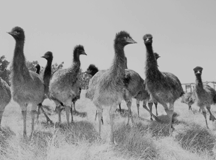Up from Down Under
Fine-feathered friends: Young emus flock together with nary a thought to just how delicious and healthful they might prove to be.
Is emu the carnivores' food of the future?
FORGET THE ASSERTIONS that rattlesnake, alligator, iguana, or frog meat "tastes just like chicken." Nobody makes any such claims for an emu. Instead, call it "the other red meat," as the recurring comparison that emu advocates offer is about as far from poultry as you can get.
"In taste, it's very similar to beef," says Dorothea Garrett of Emu Enterprises International from her Petaluma office. "The plus is that it doesn't have the calories or the cholesterol or the fat that beef does."
In addition, emu meat is high in iron and vitamin C and is said to take on seasonings and other flavors unusually well. Others compare emu meat to ranch-raised venison, another red meat that is very low in fat. Most often cut into strips or medallions, emu can be substituted for beef, pork, chicken, or turkey in many recipes, and ground emu burgers have found a ready market at adventurous drive-ins in such scattered locales as Auburn and Hopland.
But despite these attributes, emu remains an exotic novelty to most consumers, if they have heard of it at all. "It's a little difficult to sell them on something unless they can taste it themselves," Garrett sighs. "It's an educational process; it's going to take time."
NATIVE TO AUSTRALIA, New Zealand, and New Guinea, emus are large, flightless birds, members of the group known as ratites, which also include rheas, cassowaries, kiwis, and ostriches. They are somewhat smaller than ostriches, with a milder temperament, darker coloring, a shorter and less complicated digestive tract, and a higher resistance to disease.
This innate good health is important to consumers, too, as it means that emu meat is virtually chemical free. "We don't give them anything from the time they hatch until they're butchered," Garrett says. "They're probably the cleanest meat you can get."
Ah, but where to get it? Despite inroads with some restaurateurs and specialty food stores, emu meat is still not readily available to curious carnivores who don't know someone who is raising the birds. Raley's supermarkets are working on plans for some tastings and demonstrations at a handful of Northern California stores, including one in Santa Rosa, which could be scheduled as soon as early August, but no dates have been announced yet.
The biggest bottleneck right now is the lack of a local slaughterhouse. There are licensed facilities now operating outside of Fresno and near Williams, but the process of getting another up, running, and certified is dragging on.
Emu meat "must be processed in a red-meat plant, not at a poultry processor, even though it is classified as poultry," explains Bonnie Scheffler, who with her husband, Waldie, has been raising emus for 15 years at their Santa Rosa Bird Farm. But these are not typical fowl. As flightless birds with small, vestigial wings, they have no breast flesh, only dark meat that comes from the legs. The huge thighs and meaty "drumsticks" also account for most of the bird's weight, which can be 70 pounds or more for a full-grown adult after it is dressed out.
But butchering emus requires learning some specialized new skills, Scheffler notes. Red-meat plants are not accustomed to removing feathers, as poultry processors do, and even if they were, emu feathers are plucked dry, not wet like those of chickens. That's because emu feathers are a valuable byproduct, as is the featherless hide, which can be tanned into an expensive specialty leather.
In fact, virtually the entire bird is useful in some manner. The feathers are bound into feather dusters or employed in costume-making. The leather is used for belts and purses, but is considered too light and fine for shoemaking. Emu eggs, with their thick, dark green to purplish shells, are prized by artisans who decorate them, and even the birds' thick black toenails, called "black ivory" by one grower, are used to create exotic jewelry.
But the emu's single most valuable product may be the oil that is rendered from the large fatty deposit that runs along the bird's back. Traditionally used by aboriginal people to protect them from the harsh sun of the Australian outback, emu oil is sometimes used in cosmetics, where its penetrating moisture is desirable. It may also have medicinal applications, which are under study at UC Davis labs and others. According to Waldie Scheffler, one analgesic product is already widely used by professional sports teams, while burn centers also use emu oil because of its anti-inflammatory properties.
Scheffler's interest in this research is not just academic. He displays a finger that was surgically reattached after being cut off in an accident, and demonstrates the increased range of movement he has reacquired since he began applying the oil to the damaged digit. "I wouldn't be surprised if the oil becomes more valuable than the meat," he predicts. A single emu, butchered at the right time of year, can yield 16-18 pounds of fat, and it takes a little less than three pounds to make a quart of oil. "It's nothing new," Scheffler shrugs. "It's just new here."
But meat remains the primary focus of the fledgling emu industry in America, which is concentrated in Texas, California, and a few other states. Chet McIntosh, general manager of the United Ratite Cooperative in Auburn, estimates there are 1,500 emu ranchers in California, with the largest concentrations around Redding and here in Sonoma County, where nearly 100 ranchers are raising the versatile bird.
One of the local growers is Sebastopol podiatrist Jean Turner, who started in partnership with her brother just a couple of years ago with two breeding pairs and now has 100 emus "on the hoof." She says emus are an ideal animal for a small operation, as "you can farm quite a few on just a few acres." They are also inexpensive to raise, eating "about $10 of feed per month" and requiring minimal veterinary care.
The birds are not combative, and can even share a pasture with other livestock, although the breeders need to be off by themselves during the egg-laying season, which coincides with the winter months in this hemisphere. Then, their habits are remarkably regular, Turner says. The females lays an egg "at the same time, every night. Same place. Every night. Weird." Although the male will incubate the eggs in the wild--a task that takes nearly eight weeks--on farms they are promptly put into mechanical incubators. Then it takes the full 56 days to find out if an egg is fertile, as the shell is too thick for candling.
But the burgeoning number of ranches and the exponential growth of the emu head count testifies to the success the breeders have had, at least on one front. "It used to be a breeder's market," with a fertile pair selling for as much as $10,000, Turner says. "Now there are so many it's a slaughterhouse market."
As demand for emu meat grows, Turner and the Schefflers anticipate that the industry will begin to specialize, with some farms concentrating on breeding and hatching chicks, while others raise large herds and see them off to the slaughterhouse.
And the demand is growing. McIntosh says his co-op alone is now selling "a couple of tons a month, maybe five," and he notes that there are several similar groups also working in the state. Looking ahead, "We see that quadrupling by the end of the year," he forecasts. "We could grow faster, once we're satisfied we can deliver a consistent product in large quantities.
"It'll have a market share of 1 percent here in another year or so," he adds. "I think we're at the beginnings of a major industry."
This page was designed and created by the Boulevards team.

Photos by Janet Orsi

Eggs in one basket:
Bonnie Scheffler is hatching a growing emu business.
From the July 18-24, 1996 issue of the Sonoma Independent
Copyright © 1996 Metro Publishing and Virtual Valley, Inc.
